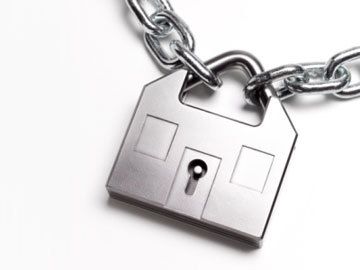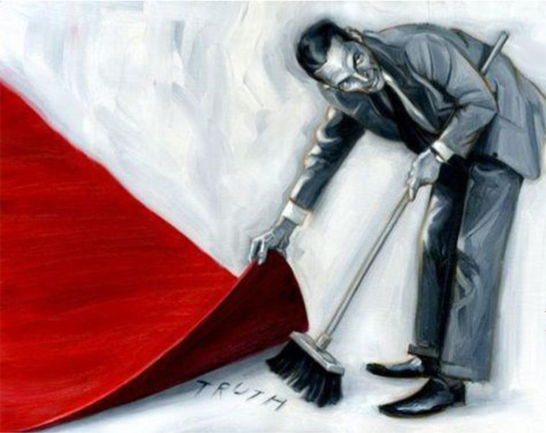THE BANKSTERS TRAP FOR LOAN SEEKERS ~
A few years before I, or most of the rest of the world, ever heard of the “Montana Freemen,” there was a Colorado Freeman already attempting to exercise his rights in a similar manner as described in my 1996 book, THE MONTANA FREEMEN – The Untold Story.
Earlier this year, Mark Emery released his new book, ONE FREEMAN’S WAR – in the Second American Revolution, which describes with inside information the frustrating efforts of that American patriot’s struggle to break through the government wall shielding liberty from “We the People.”
Not unlike Bill Bicket’s story in Miracle in Atlanta, Emry describes his background of learning the historical truth, the legal distortion of it and then the defense of his newly found knowledge after being attacked by those defending the modern lies. His legal defense and courtroom activity is a roller coaster ride of “What’s next?” (See www.onefreemanswar.com)
 Having “mused” (rather moaned) for decades about the crooked banking monopoly administered worldwide by the Federal Reserve System and locally by your friendly bank president, I took particular interest in Mark’s Chapter 15 that explains the fraud in mortgage loans clearly enough for your high school age kids to understand the ploy. I decided to make the information available in this November Musings. Some would say right here without having read it yet that it will certainly be better than my October Musings; while, on the other hand, some may be already saying that the October column was the best one I ever did. (Never got around to it.)
Having “mused” (rather moaned) for decades about the crooked banking monopoly administered worldwide by the Federal Reserve System and locally by your friendly bank president, I took particular interest in Mark’s Chapter 15 that explains the fraud in mortgage loans clearly enough for your high school age kids to understand the ploy. I decided to make the information available in this November Musings. Some would say right here without having read it yet that it will certainly be better than my October Musings; while, on the other hand, some may be already saying that the October column was the best one I ever did. (Never got around to it.)
While Mark says that he must give much of the credit for this information to Tom Schauf (whatever happened to Tom? I used to read his stuff with great admiration and respect for his knowledge), where he first learned it, I say that Tom wasn’t born with it either and had to learn it from someone or somewhere else. The only change in one’s life between having finished school and today are the books we read and the people we meet. Tupper Saussy was my mentor on the money subject, and apparently Tom Schauf was Mark Emery’s.
So the lesson of the day is the previously mentioned mortgage lending fraud. Let’s look at the actual loan transaction and see how this works.
First of all, the promise of all bank loans is that the bank has all this money on hand and wants to loan you some of it. If you qualify, the bank will loan you some of its money as long as you promise to pay it back with a fee (points and/or interest). Just to make sure the bank doesn’t lose its money, the gang of thieves will usually get you to give them the beneficial interest (ownership) in your property (collateral) until the contract is fulfilled. This is how most of us are led to believe the bank loan transaction works, but it’s a fairytale. Let’s analyze it.
The Mechanics of Bank Fraud
 First, the bank doesn’t care much if you qualify when you can offer tangible property as collateral because they know that mathematically they will foreclose on a certain amount of property without having risked anything to get it, and this adds significantly to the bottom line. But they maintain the illusion that credit qualifications are important because this covers what they are really doing.
First, the bank doesn’t care much if you qualify when you can offer tangible property as collateral because they know that mathematically they will foreclose on a certain amount of property without having risked anything to get it, and this adds significantly to the bottom line. But they maintain the illusion that credit qualifications are important because this covers what they are really doing.
Secondly, once you (or more accurately your collateral) have been approved, nothing happens until you sign a ‘promissory note’ and give it to the bank.
Remember a ‘note’ is one of four forms of negotiable instruments identified in the U.C.C.;
1) Note
2) Check
3) Draft
4) Certificate of Deposit.
Negotiable instruments are used as ‘money’ being instruments of debt and credit. Remember, ‘credit’ is the medium of exchange (falsified as “money”) which we use daily in almost every transaction.
Now pay attention to what the bank does in its books to reflect the loan transaction: Your note is deposited as an asset to the bank and is credited to the bank’s asset base. If you understand double entry bookkeeping, you know the bank must now enter a debit entry to offset its credit entry and zero it out. The account which gets debited is the bank’s checking account demand deposits or DDA (demand deposit account). In bookkeeping terms a debit is a liability. Remember this, as it will be important in just a minute.
What the bank did here so far was to deposit your promissory note as ‘money’ on its books. Then they transferred your ‘money’ into the bank’s checking account as if it were their own and did so without your permission. For starters, this is fraud and criminal conversion and a felony offense. Your local bank president should be charged, arrested and tried for these crimes; and the bank’s board of directors should sit as defendants in a civil suit brought by every homeowner in town that has been suckered into this fraudulent financial trap.
It is out of this checking (demand deposit) account that the bank writes you the check for the loan. Now let’s examine a few things right here.
One: remember just a minute ago when we saw that a debit is a liability? The ‘money’ deposited into the bank’s checking account was a debit (liability) right? And the bank just wrote you a check (loan) from that account, right? Well if a debit is a liability and the check was written from that debit account, then what the bank actually loaned you was a liability and not an asset! Weren’t you led to believe that ‘money’ is an asset and that’s what you wanted to borrow? What does the loan contract say, that you are being loaned an asset? or a liability? Are you starting to get the picture? Let’s look further now.
The next thing to recognize is the fact that the bank deposited your note as ‘money’ on its books. They transferred that ‘money’ to another account and gave it back to you in the form of a bank check, didn’t they?
 Now you say, “Wait a minute. I thought I was borrowing the bank’s money not my own!” You’re right! That was what you thought, but they tricked you. Not only did they trick you with deceptive and misleading advertising: “Money to Loan”, but they are making fees (points and interest) off of loaning you your own money and forcing you to risk your own collateral for the privilege!
Now you say, “Wait a minute. I thought I was borrowing the bank’s money not my own!” You’re right! That was what you thought, but they tricked you. Not only did they trick you with deceptive and misleading advertising: “Money to Loan”, but they are making fees (points and interest) off of loaning you your own money and forcing you to risk your own collateral for the privilege!
Now at this point the reader undergoes an attack of “Red, White & Blue Fever.” [“This can’t be. The government would never allow this fraud to continue.” Sorry, Bud, but it’s a century old now without any legal interference.]
Admissions from the Fed
The Federal Reserve tells us point blank how this works in their own publication entitled, “Modern Money Mechanics” which was free for the asking from the Chicago Federal Reserve Bank public information officer and may still be available online.
They are not ashamed at all about their banking practices as is exhibited by the following excerpts from that publication:
“What Makes Money Valuable? In the United States, neither paper currency nor checking and savings deposits have value as commodities. Intrinsically, a dollar bill is just a piece of paper, deposits merely book entries. Coins do have some intrinsic value as metal but generally far less than their face value.
What then makes these instruments – checks, paper money, and coins acceptable at face value in payment of all debts and for other monetary use? Mainly it’s the confidence people have that they will be able to exchange such money for other financial assets and for real goods and services wherever they choose to do so.’
What do you think about that? Was it what you would expect the Federal Reserve to tell you? It gets better as the deception continues to be explained in the same publication.
“Who Creates Money? Bankers discovered that they could make loans merely by giving their promise to pay (liability in the form of a check from a debit ‘DDA’ account) or bank notes (Federal Reserve Note) to borrowers. In this way, banks began to create money. More notes could be issued than the gold and coin on hand because only a portion of the notes outstanding would be presented for payment at any one time. Enough metallic money had to be kept on hand, of course, to redeem whatever volume of notes was presented for payment (prior to 1933 anyway).”
Transaction deposits are the modern counterpart of bank notes. It was a small step from printing notes to making book entries crediting deposits of borrowers (your note), which in turn the borrowers could spend by writing checks, thereby printing their own money.
There you have it! The Fed admits that YOU created your own money by depositing your note with the bank. So they don’t really have any “money to loan” as they advertise.
Stop and take a breath. Let’s think about this for a minute. By the way, the parentheses above are insertions by this author.
What did the Federal Reserve tell us above?
ONE: Bankers make loans by giving their promise to you (liability).
This promise to pay never gets paid does it? The banker gives you a check which can only be cashed in Federal Reserve Notes. A Note is nothing more than a promise to pay. So the bankers’ promise to pay is only redeemable in the Fed’s promises to pay. They know now that a Federal Reserve Note is not redeemable in anything of value by any bank. So all you got from the banker was a promise to pay which never gets paid. A liability that gets passed on but never settled.
You put up your property, a tangible asset of value as collateral. You signed a contract to pay the banker back in assets, the hard earned fruit of your labor, and all he gave you was a liability. He never had any money to loan you in the first place. He loaned you money that you created, your own money! And now, in the case of a 30 year mortgage you are going to pay the bankers three times the amount you loaned to yourself!? What was the bankers’ risk? Nothing. What did the banker do to earn 30 years of your labor? Nothing. What did the banker do to earn the right to steal your house from your family if you get laid off after paying him for twenty years and can’t make a few payments? Nothing.
TWO: “Banks create money. Credit and liabilities.
Didn’t the people, the principals and creators of government, delegate our power to create money (substance) to Congress (our agent)? Didn’t we (the People) put in the constitution that it was unlawful for any state to emit bills of credit? Wasn’t it unlawful for Congress to delegate their limited authority to coin money of substance? We delegated this power to them them alone, not to private bankers most of whom are not even Americans?
THREE: “Only a portion of those notes outstanding would be presented for payment at any one time.”
This is false and misleading. The bankers now are dealing in Federal Reserve Notes which are NON-REDEEMABLE period! Take one into any bank anywhere and ask them to redeem your $ 10 biII. See what happens. Put yourself in the bankers’ shoes. It’s a pretty nice racket, huh? You get liens on everyone’s property, homes, cars, RV’s, incomes, labor, etc., and you not only don’t have to put up a dime of your own but you know your lousy bank notes wiII never be calIed for actual payment in substance either. You’ve got the best of both worlds! Regular people go to jail for Ponzi schemes like this!
FOUR: “It was a small step from printing notes to making book entries.”
Money is nothing more than book entries made by the banker after he locks in your collateral and promise to pay. He knows that since he only created the principal amount of the loan in new ‘money’ and the money to pay the interest on all of his loans is never created. Then by pure mathematics some people are guaranteed to fail on his loans and he will get his collateral, your property, your substance… Free and clear through foreclosure.
Since the borrower is, in effect printing (figuratively) and borrowing his own money, the banker is nothing more than a paper shuffler who wiII collect so much collateral without risking one thin dime of his own. Question: If you created the money via your promissory note, couldn’t you discharge your liability with another note, which is the current medium of exchange that exists today? This has been done!
Using this information as a basis for his work, Tom told us that his bank auditor friend was very concerned about this information getting out to the public for fear that if the American people understood all of this, in his words, “they would demand that all the bankers, lawyers and bank auditors be sent to jail.”
 He explained that it is the same set of bookkeeping entries that would occur as if a burglar stole your property and returned the stolen property back to you, the victim, and called it a loan. Then the victim must repay the principal and interest to the thief who stole the property in the first place!
He explained that it is the same set of bookkeeping entries that would occur as if a burglar stole your property and returned the stolen property back to you, the victim, and called it a loan. Then the victim must repay the principal and interest to the thief who stole the property in the first place!
The auditor told Tom that obviously the bank doesn’t want people to know about both halves of the transaction. This is the oldest bank trick in the world and it keeps its victims, the American people in debt and forever paying interest and property (through foreclosures) to the bankers who never loaned one red cent of legal tender, or other depositor’s money, to obtain the promissory notes.
“The real truth of the matter is, as you and I know, that a financial element in the large centers has owned the government of the U.S. since the days of Andrew Jackson.” –– Franklin D. Roosevelt in a letter written Nov. 21, 1933 to Colonel E. Mandell House
